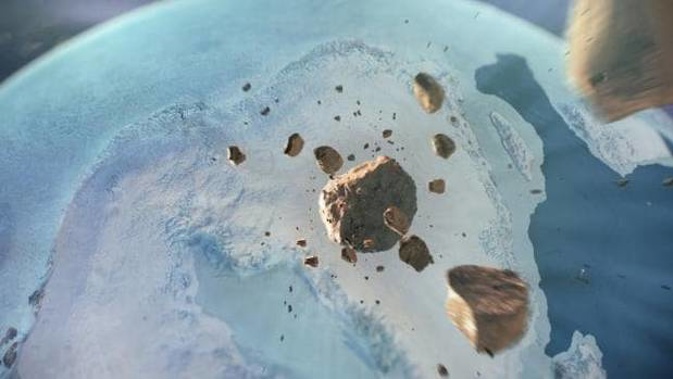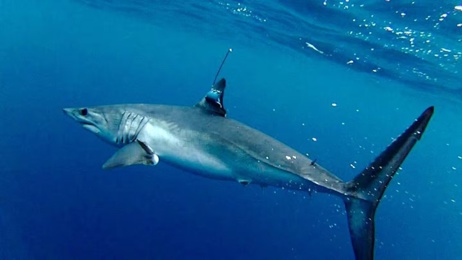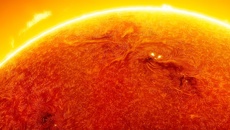
A massive iron meteorite smashed into Greenland as recently as 12,000 years ago, leaving a crater bigger than Paris that was recently discovered beneath the ice with sophisticated radar.
The crater is the first of its kind ever found on Greenland — or under any of the Earth's ice sheets — and is among the 25 largest known on Earth, said the report in the journal Science Advances.
It is estimated the asteroid would likely have been made largely of iron, measuring about 1.5km across and weighing about 12 tons. The impact which created the 31 kilometres wide crater under the Hiawatha Glacier would have had significant ripple effects in the region, possible even globally, researchers said.
But its story is just beginning to be told.
If confirmed, it could have major implications for the tale of humanity itself.
If confirmed, its dating could establish the Younger Dryas impact hypothesis as fact. It's a somewhat controversial idea that a large impact in North America some 11,000 to 13,000 years ago during the last Ice Age caused massive wildfires across much of the Americas and Europe, as well as unsettling the weather conveyor belt of the North Atlantic current.
This in turn lead to the extinction of many megafauna mammals, such as the mammoth and mastodons — and possibly the early humans then occupying the Americas.
DEEP IMPACT
It would have been a spectacle seen across much of the Northern Hemisphere — a huge fireball many times brighter than the Sun, streaking across the sky.
Then it struck Greenland.
The resulting impact would have flashed across North America — sending molten projectiles spearing into forests over thousands of square kilometres and setting off enormous fires. And then the tsunamis and clouds of vaporised ice and bedrock circled the globe.
The impact would have been huge. But nowhere near as devastating as the dinosaur-killer strike that created the Chicxulub impact crater — some 200km wide — in Mexico some 66 million years ago.
"It's likely quite young, geologically speaking," says study co-author Joseph MacGregor, a glaciologist with the NASA Goddard Space Flight Center. "It's likely less than three million years old and possibly as young as 12,000 to 15,000 years old."
Massive crater larger than Washington, D.C. found under Greenland's ice.https://t.co/gWTXV4CTGF Story by @voooos and the graphic by @cbickel27 @sciencemagazine #ScienceVisuals pic.twitter.com/jzIUlsHqqe
— Science Visuals (@ScienceVisuals) November 14, 2018
But does the Greenland crater clinch the Younger Dryas impact hypothesis?
"It's a very speculative idea, but if this does turn out to be (the missing link), it would have had an outsize impact on human history," McGregor says.
"We do not discuss it in the paper, but I think it is a possibility," adds lead author Kurt Kjær, a glacial geologist and curator at the Natural History Museum of Denmark and the University of Copenhagen. "This may generate a lot of discussion, and we need to find out. We won't know until we have a proper date."
UNEARTHING A CRATER
The discovery was initially made in the 2015 but an international team of researchers has been working to verify the findings ever since.
The initial finding was made with data from NASA's Program for Arctic Regional Climate Assessment and Operation IceBridge.
More data was collected since then, using more advanced radar technology.
/arc-anglerfish-syd-prod-nzme.s3.amazonaws.com/public/3LE2ECLFFFEITLKZST3IQOZDRU.jpg)
The hidden crater stretches nearly 20 miles (31km) wide. A prominent rim surrounds the depression. Photo / Science
"So far, it has not been possible to date the crater directly, but its condition strongly suggests that it formed after ice began to cover GreenlandProfessor Kjaer says.
Researchers plan to try and recover material that melted from the bottom of the glacier to learn more about its timing and effects on life on Earth at the time.
Such a dating would vindicate Younger Dryas impact theorists.
"I'd unequivocally predict that this crater is the same age as the Younger Dryas," says James Kennett, a marine geologist at the University of California, Santa Barbara and one of the idea's original supporters, told Science.
The climate chaos, the theory argues, would explain why the Clovis peoples' settlements were abandoned and the megafauna vanished soon afterwards.
Not all agree.
"This is a hot potato," impact crater expert at Purdue University in West Lafayette, Indiana, Jay Melosh told Science. "You're aware you're going to set off a firestorm?"
Lloyd Keigwin, a paleoclimatologist at the Woods Hole Oceanographic Institution in Massachusetts says there is only one solution.
"Somebody's got to go drill in there … That's all there is to it."
Take your Radio, Podcasts and Music with you









